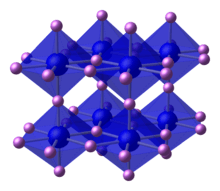Lithium nitride
 | |
| Names | |
|---|---|
| Preferred IUPAC name
Lithium nitride | |
| Other names
Trilithium nitride | |
| Identifiers | |
| 26134-62-3 | |
| 3D model (Jmol) | Interactive image |
| ChEBI | CHEBI:30525 |
| ECHA InfoCard | 100.043.144 |
| EC Number | 247-475-2 |
| |
| |
| Properties | |
| Li3N | |
| Molar mass | 34.83 g/mol |
| Appearance | red, purple solid |
| Density | 1.270 g/cm3 |
| Melting point | 813 °C (1,495 °F; 1,086 K) |
| reacts | |
| log P | 3.24 |
| Structure | |
| see text | |
| Hazards | |
| Main hazards | reacts with water to release ammonia |
| Related compounds | |
| Other anions |
Lithium oxide |
| Other cations |
Sodium nitride |
| Related compounds |
Lithium amide Lithium imide |
| Except where otherwise noted, data are given for materials in their standard state (at 25 °C [77 °F], 100 kPa). | |
| | |
| Infobox references | |
Lithium nitride is a compound with the formula Li3N. It is the only stable alkali metal nitride. The solid is a red or purple color and has a high melting point.[1]
Preparation and handling
Lithium nitride is prepared by direct combination of elemental lithium with nitrogen gas:[2]
- 6 Li + N2 → 2 Li3N
Instead of burning lithium metal in an atmosphere of nitrogen, a solution of lithium in liquid sodium metal can be treated with N2. Lithium nitride reacts violently with water to produce ammonia:
- Li3N + 3 H2O → 3 LiOH + NH3
Structure and properties
alpha-Li3N (stable at room temperature and pressure) has an unusual crystal structure that consists of two types of layers, one sheet has the composition Li2N− contains 6-coordinate Li centers and the other sheet consists only of lithium cations.[3] Two other forms are known: beta-Lithium nitride, formed from the alpha phase at 4,200 bars (4,100 atm) has the Sodium arsenide (Na3As) structure; gamma-Lithium nitride (same structure as Li3Bi) forms from the beta form at 35 to 45 gigapascals (350,000 to 440,000 atm).[4]
Lithium nitride shows ionic conductivity for Li+, with a value of c. 2x10−4Ω−1cm−1, and an (intracrystal) activation energy of c. 0.26eV (c.24 kJ/mol). Hydrogen doping increases conductivity, whilst doping with metal ions (Al, Cu, Mg) reduces it.[5][6] The activation energy for lithium transfer across Lithium nitride crystals (intercrystalline) has been determined to be higher at c. 68.5 kJ/mol.[7] The alpha form is a semiconductor with band gap of c. 2.1eV.[4]
Reaction with hydrogen at under 300 °C (0.5MPa pressure) produces Lithium hydride and Lithium amide.[8]
Lithium nitride has been investigated as a storage medium for hydrogen gas, as the reaction is reversible at 270 °C. Up to 11.5% by weight absorption of hydrogen has been achieved.[9]
References
- ↑ Greenwood, Norman N.; Earnshaw, Alan (1997). Chemistry of the Elements (2nd ed.). Butterworth-Heinemann. ISBN 0-08-037941-9.
- ↑ E. Döneges "Lithium Nitride" in Handbook of Preparative Inorganic Chemistry, 2nd Ed. Edited by G. Brauer, Academic Press, 1963, NY. Vol. 1. p. 984.
- ↑ Barker M.G.; Blake A.J; Edwards P.P.; Gregory D.H.; Hamor T. A.; Siddons D. J.; Smith S. E. (1999). "Novel layered lithium nitridonickelates; effect of Li vacancy concentration on N co-ordination geometry and Ni oxidation state". Chem. Commun. (13): 1187–1188. doi:10.1039/a902962a.
- 1 2 Walker, G, ed. (2008), Solid-State Hydrogen Storage: Materials and Chemistry, §16.2.1 Lithium nitride and hydrogen:a historical perspective
- ↑ Lapp, Torben; Skaarup, Steen; Hooper, Alan (October 1983), "Ionic conductivity of pure and doped Li3N", Solid State Ionics, 11 (2): 97–103, doi:10.1016/0167-2738(83)90045-0
- ↑ Boukamp, B.A.; Huggins, R.A. (6 Sep 1976), "Lithium ion conductivity in lithium nitride", Physics Letters A, 58 (4): 231–233, doi:10.1016/0375-9601(76)90082-7
- ↑ Boukamp, B.A.; Huggins, R.A. (January 1978), "Fast ionic conductivity in lithium nitride", Materials Research Bulletin, 13 (1): 23–32, doi:10.1016/0025-5408(78)90023-5
- ↑ Goshome1, Kiyotaka; Miyaoka2, Hiroki; Yamamoto1, Hikaru; Ichikawa3, Tomoyuki; Ichikawa1, Takayuki; Kojima1, Yoshitsugu (2015), "Ammonia Synthesis via Non-Equilibrium Reaction of Lithium Nitride in Hydrogen Flow Condition", MATERIALS TRANSACTIONS, 56 (3): 410–414, doi:10.2320/matertrans.M2014382
- ↑ Ping Chen, Zhitao Xiong, Jizhong Luo, Jianyi Lin and Kuang Lee Tan (2002). "Interaction of hydrogen with metal nitrides and amides". Nature. 420 (6913): 302–304. doi:10.1038/nature01210. PMID 12447436.
